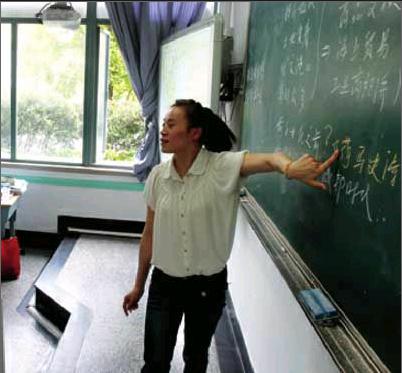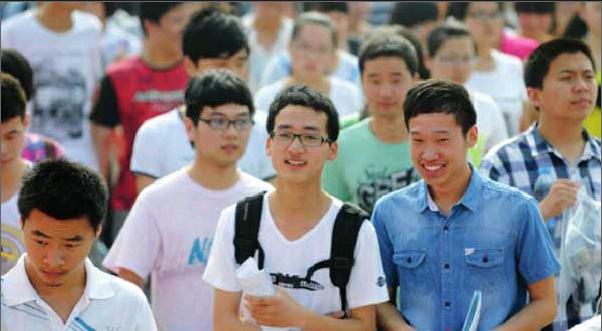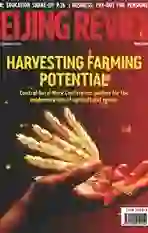Examining the Exam System
2015-01-29ByYinPumin
By+Yin+Pumin


After years of consideration and reconsid- eration, the Chinese Government finally decided to reform its college entrance exam, also known as the gaokao, aiming to reverse exam-oriented education to help fuel future growth.
Following the State Councils general guidelines in September last year, the Ministry of Education (MOE) announced specific reform measures of the gaokao system on December 16, asking universities not to base their judgment of applicants solely on scores but to make comprehensive assessments of applicants.
The current situation is that most students undertake a fixed, universal diet of exam subjects in either the sciences or arts.
In the future, students will be allowed to submit the scores of three subjects from a pool of six—biology, chemistry, geography, history, physics and politics—together with their mandatory Chinese, math and English scores.
“The new regulation will help students take advantage of their strengths and overcome their shortcomings,” said Zhou Bin, a schoolmaster from Haining, east Chinas Zhejiang Province, adding that students often paid too much attention to their weaknesses.
China resumed the gaokao system in 1977. Since then, the exam has been called a“single-plank bridge” because it is the only way for youth to obtain a promising career beyond vocational training.
MOE figures show that 9.39 million students took the gaokao last year, an increase of 270,000, or 3 percent, from 2013. In 1998, the figure was 1.08 million, but after recruitment was widened in 1999, the number has soared.
However, with limited slots for university education, competition for entrance into higher education institutions is cutthroat and heavily reliant on gaokao scores.
As a result, students are often trained to focus only on test scores, memorizing endless lists of textbook answers instead of developing a sense of independent and innovative thinking.
This time, the sweeping changes to the gaokao system put emphasis on all-around development in pursuit of the countrys untapped talent. “If this can be achieved, students will have more independence and can make choices that align with their educational ambitions,” said Xiong Bingqi, Deputy Director of the Beijing-based 21st Century Education Research Institute.
Two pilot regions
On September 4, 2014, the State Council, Chinas cabinet, released the reforming guideline for the countrys gaokao system. It selected Shanghai Municipality and Zhejiang Province as two testing grounds for the reform.
The two pilot regions then announced their own reform plans, promising to allow their high school students to learn a wider range of subjects. The reform plans of both regions said that the annual gaokao will no longer be the only criterion for college admission and that students will not be forced to choose a preference in majors from either liberal arts or sciences.
With the changes, students will still be tested on Chinese, math and English. But for the three remaining subjects, students in Shanghai and Zhejiang can choose to be tested on a wider range of topics from geography, history, chemistry, biology, physics and politics, among others. Starting in 2015, the first selective classes will begin at several high schools in the two regions, according to the pilot plans.
Chen Weixin, a teacher with the Enrollment Administration Office of Shanghai Fudan Secondary School, said the school will open six selective classes including politics, history, geography, physics, chemistry and life sciences for students. Students can make the decision on which three classes they want to choose to have the final scores included in their gaokao scores at the end of the second senior one semester.
Chen said the new system also allows academically gifted students to advance to a higher-level class according to their performance.
Shanghai Shibei Secondary School also confirmed they will change their curriculum to align with the gaokao reform beginning in 2015.
The schools principal Chen Jun said they have already opened opportunity classes for gifted students. In the coming months within 2015, the school will further specify curriculum changes involving the new selective classes.
Based on Shanghais education reform plan, in 2017 higher learning institutions will have the freedom to enroll students with special academic gifts rather than simply considering the unified exam scores.
Under the new enrollment scheme, colleges may favor a student by taking into consideration the score of one of the students three selective classes.
Ye Zhiming, President of Shanghai University, said the reform gives universities more autonomy in choosing students to study specialized subjects.
Chi Xuewei, Principal of the Changchun Experimental Secondary School in Changchun, northeast Chinas Jilin Province, said that the selective-class teaching method breaks the traditional fixed class arrangement in Chinese high schools, and encourage students to plan for their academic future during their secondary school education.
Chi has been closely following the education experiments in Zhejiang and Shanghai since September last year.
“Under the current system, students bury themselves in study for 12 years of primary and secondary education, and only start to think what they would do in the future after gaokao,” said Chi. He said the reform will help inspire student potential and encourage indepth pursuit of their gifted subjects.
In the new pilot programs, both regions will also do away with the former gaokao system in which 12th-graders took tests on six subjects in just three days. The students can take examinations on subjects other than math and Chinese twice between the 11th and 12th grades and submit the highest score to their college applications.
Liu Xiping, Director of the Zhejiang Provincial Department of Education, said at a news conference on September 19, 2014, that the new plan is to reduce the burden of the exams by splitting them into different periods.
Dai Xiaoping, an expert with the Zhejiang Research Institute of Education Science, said the reform will improve the quality of high school education in the long run.
“Currently, 12th-graders last year in high school is extremely stressful because of the gaokao. They have to work very hard on at least six subjects during that year. With the reform, they can distribute what they study into different periods, which will help them learn each subject better,” she said.
However, other experts think the changes may also introduce more pressure.
Students would have to fight “a prolonged battle” as a result, said Xiong with the 21st Century Education Research Institute. “In a way they will face gaokao levels of pressure from the first day of high school, knowing the scores they gain in the first two years also have a say in the university admission procedure.”
Liu, with the provincial education department, said measures will be adopted to ensure that high schools do not arrange their curricula only for exams.
“The ultimate goal of the reform is to improve the quality of the education. Students are the first concern with this plan,” he said.
Lu Jia, a teacher at Hangzhou Yuanqing High School, said rearranging curricula will be a challenge for high schools.
“Since students will choose different subjects, dealing with how to put them into class units is a challenge. For teachers, balancing classes according to tests is another challenge. We are still working on these issues,” she said.
Meanwhile, according to the new guidelines released by the MOE on December 16 last year, the two pilot regions also rectified their pilot plans to grade the students selected courses in levels but not score them.
“In this process, the biggest public concern is the abuse of power. People are worried that the admission will have no clear standard if the significance of scores is reduced,” said Chu Zhaohui, a researcher at the Beijing-based National Institute of Education Sciences. “We need more professional and persuasive replacements to convince the public that the change will not damage fairness but evaluates applicants more comprehensively,” Chu said.
Promoting fairness
During a news conference on September 4 last year in Beijing, Vice Education Minister Du Yubo said the ongoing reform on the gaokao system is aimed at promoting fairness and supervision and connecting all levels and types of education.
“Education reform is a complex project involving all levels of society. Its reasonable for the Central Government to have educational fairness, the top concern of the public, as its first priority,” said Yang Dongping, a professor at Beijing Institute of Technology.
In a move to promote fairness in the gaokao, the MOE announced in its reforming measures on December 16 last year that math, science and sport competition winners will no longer receive extra points on their college application. The move looks to respond to social concerns as bonus points can be easily manipulated through bribes, the ministry said.
For years, China has adopted a policy of awarding extra credit to college applicants who win major sports events, math or science competitions, which has prompted a boom in math and science training centers. Bonus points are also common for students from Taiwan, ethnic minorities and returned overseas Chinese.
The “extra points” policy was designed to make up for the weakness of the traditional gaokao, which solely focused on studentsacademic performance while ignoring nonacademic skills. It was designed to encourage rounded development of students.
However, due to lack of supervision, the policy has led to corrupt admission procedures in many places, generating public dissatisfaction. It is believed that terminating the policy will clean admission procedures.
In a high-profile college admission scandal in the summer of 2014, 87 out of around 1,000 gaokao participants of a high school in Benxi, northeast Chinas Liaoning Province, were initially awarded extra points since they possessed athletic certificates. This was only two less than the total number of students with extra points for sporting talent in the combined school for five other cities in Liaoning, aroused suspicion. Later the provincial education authorities ordered reexaminations. They found 66 of the schools 87 students voluntarily gave up the test and their privileges were canceled.
However, with the policy of discarding extra bonus, there emerged a concern that students and parents may lose passion on developing non-academic skills due to the policy change. But Ye Zhiming, Vice President of Shanghai University, believed one of the new measures has pointed to a solution.
The measure said schools should build profiles for students, which include not only their academic scores, but also evaluation on their special talents, moral condition as well as physical and mental health.
“Hopefully, the profiles recording studentsoverall quality can replace the ‘extra points system,” Ye said.
In another move to promote fairness, the MOE said it will continue its efforts to narrow the gap in college enrollment in different regions to ensure nationwide equality in higher education.
Vice Education Minister Du said that by 2017, the gap between provinces and regions with the lowest college enrollment rate and the national average should be no more than 4 percentage points.
Narrowing the regional gap in college enrollment and ensuring that students from across the country have equal access to higher education is one of the focuses of the reform. Du said the government has been taking measures to narrow the gap.
By implementing a preferential enrollment policy that requires colleges to recruit more students from central and western regions, 200,000 students from these regions have been recruited since 2008, Du said.
He also said that in 2013, the lowest college enrollment rate among all provinces and regions in China was 70 percent, or 6 percentage points lower than the national average, while the gap in 2007 was 17 percentage points.
Rural students have gained greater access to good universities, with the implementation of a policy to improve their chances of being admitted by such universities. The policy, which took effect in 2012, covers 832 impoverished counties nationwide.
“In 2014, 50,000 rural students were admitted to good universities, marking an 11.4 percent increase from 2013,” Du said.
To achieve the goal set for 2017, Du said, the ministry will continue implementing preferential-enrollment policies, while fully considering regional differences when drawing up each years recruitment plan. The ministry will also consider many other factors, including the number of students, education resources and the graduates employment prospects.
